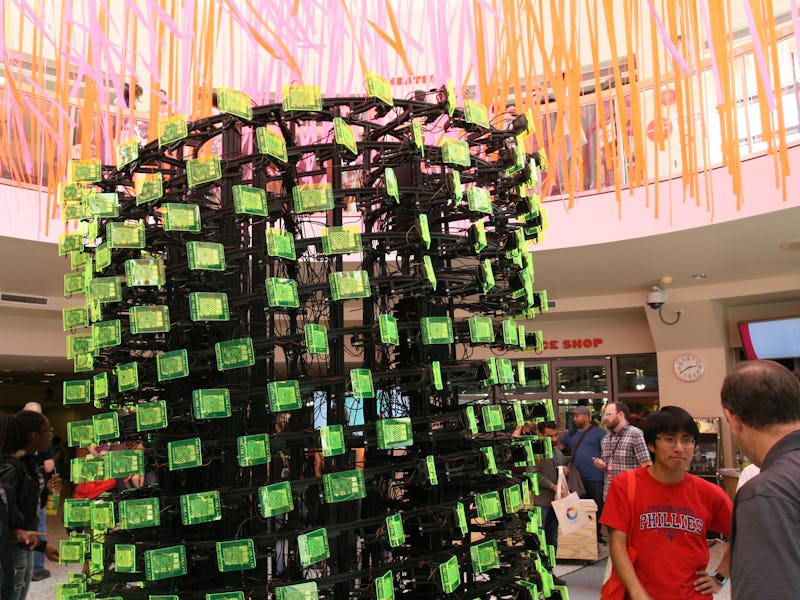Meet SeeMore: Maker Faire’s Mesmerizing 256-Node Computer Cluster
One artist + one computer engineer = a trippy parallel computer project.

If you happened to be at World Maker Faire in Queens, New York this past weekend, you probably stumbled upon a gargantuan cylinder plastered with hundreds of green-translucent electronics panels, occupying the bottom floor of a round atrium at the edge of the New York Hall of Science building. You might have walked past, and noticed the panels moving back and forth like robotic leaves in the wind. And chances are, you had no clue what this thing was or how it worked and even why it worked.
The big hunk of wiring and circuitry is called SeeMore, a 256-node animatronic computer cluster designed by sculptor Sam Blanchard and computer scientist Kirk Cameron at Virginia Tech. SeeMore was a cross-disciplinary collaboration meant to show the workings of parallel computing to a general audience. Blanchard calls it a project in “physical data visualization that demonstrates the changes occurring.”
Check out the video below. If you still have no idea what’s going on, keep reading to find out.
For the uninitiated, parallel computing is a type of process in which multiple computers run calculations simultaneously, working together to operate essentially as a single mega-computer. Dividing the tasks among individual systems makes things run more quickly and efficiently.
You see parallel computing all around us, every day. Google uses parallel computing to bring you your results when you type something into the search bar. Siri uses parallel computing when you ask about the weather. All these individual systems are responding to single tasks or pulling up individual bits of information when you send out the request.
Despite how essential parallel computing is to our lives, Cameron kept running into issues explaining these designs to the public, or recruiting students to the CS program at Virginia Tech. He wanted to develop a tool that better explained it, and that’s where Blanchard and Cameron began SeeMore.
SeeMore is covered in 256 individual Raspberry Pi computers — low power microcontrollers designed for amateur hacking and DIY projects. Together, they operate as a parallel computing cluster — “parsing up and down a search database,” says Blanchard.
Each Raspberry Pi is attached to a 90-degree reticulating motor that moves side-to-side. When it’s lying flat (or parallel to the central structure), it’s idle. When you see it move out, that means it’s “fully under load” — it’s computing something and accomplishing a task.
A central node is dividing search tasks up among the 256 Raspberry Pis, based on a specific algorithm. “The patterns that you see is the way the ‘head’ node delegates these tasks,” says Blanchard. “You see when all those tasks are completed, each computer files back to the head node.”
What exactly are all these computers looking for? Blanchard and Cameron designed SeeMore to search through City Record Online (CROL), an open data network containing city records on a wide variety of things, from a list of bus breakdowns, to incarceration stats, to rates of transmissions for sexually transmitted diseases. In this instance, SeeMore would accept a search term and respond by looking through a five-gigabyte set of everything tagged with a geographical location — like trees, park benches, post offices, historical landmarks, etc — retuning location results.
Let’s say you typed in subway stops. SeeMore would parse through for data on anything relevant to within one block of a subway stop. “It could be something like one theater, three libraries, 47 restaurants — whatever,” says Blanchard. “You get all the hits. It’s very much analogous to the amount of processing power and scale with which we search the Internet.”
“The overall goal,” he says, “is to get us to stop thinking of computers in a black box,” — that idea that you throw something into a machine and it magically comes back with what you need.
Blanchard, in charge of the sculptural elements of the projects, was really influenced by DIY design concepts. He wanted something that looked stripped down and basic — where the USB wires and Ethernet cables were showing, and the electronics on each computer were visible. The name SeeMore was chosen as an homage to Seymour Cray, the father of supercomputing.
Blanchard and Cameron haven’t yet discussed what a follow-up project might look like, but Blanchard has some ideas. He wants to make something that would be more interactive with the audience — both digitally and physically. A future system might pull from data it finds on social media or from live RSS feeds. It might move according to individuals’ movements. “I saw people who would walk past and try to make the computers move with their hands,” he says. “They must’ve thought the system was responding to their own movements.” That wasn’t the case, but Blanchard would like to implement something like that in a future system.
If that’s the case, I suggest a name for a follow-up system: “SeeEvenMore.” Get it?